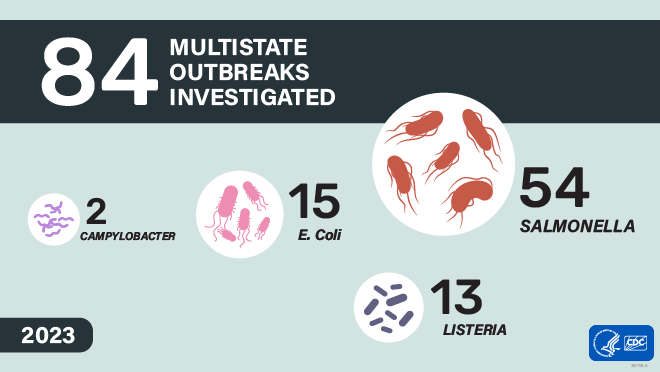At a glance
Food Safety Updates From CDC is an electronic newsletter of food safety news for educators, consumer advocates, government officials, and industry representatives.

National Food Safety Education Month
Kids First: Food for Healthy Futures

September is National Food Safety Education Month and this year we are shining a spotlight on food safety for kids! We encourage adults to help young people everywhere learn simple, smart food safety practices that can keep them healthy for life. When we teach kids these important habits early on, we're not just preventing illness, we're helping them become confident, informed decision-makers in their homes, schools, and communities as they grow older. It's a chance to spark a movement where the next generation leads the way in creating a culture of food safety and healthy practices.
Home Canning Caution: Botulism Outbreak Report

Published in July, this report focuses on a foodborne botulism outbreak that highlights the risks of improperly preserved foods. In June 2024, eight attendees of two related family gatherings in Fresno County, California, were infected with the toxin that causes botulism after consuming home-canned prickly pear cactus pads (nopales), a popular cuisine in traditional Mexican culture. This outbreak marks the first known cases of botulism linked to home canning nopales. Prevent illness when preserving food in your home by following safe canning instructions and using the right equipment.
Raw Milk Caution: Salmonella Outbreak Report

Also published in July, this report brings to light a 2023 Salmonella outbreak linked to unpasteurized (raw) milk from a dairy farm in San Diego County, California, that led to 171 illnesses in 4 states. The outbreak investigation noted 70% of infected people, many of whom were children and adolescents, consumed the unpasteurized milk or heavy cream that contained the strain of Salmonella linked to the outbreak. This outbreak highlights the significant risk of illness associated with consuming raw milk. People who are at higher risk can have severe illness and complications from drinking raw milk.
Persisting Strains of Salmonella Cause Hundreds of Illnesses Each Year

CDC, state, and federal partners identify, track, and investigate reoccurring, emerging, or persisting (REP) strains of bacteria in the United States. Persisting strains can cause illnesses over months or years despite efforts to prevent infections. Two persisting strains of Salmonella continue to cause hundreds of multidrug-resistant gastrointestinal illnesses each year.
- Salmonella Infantis (REPJFX01): CDC began investigating this strain in 2015, linking many infections to chicken produced in the United States and finding illnesses that occurred as early as 2012.
- Salmonella Newport (REPJJP01): CDC began investigating this strain in 2016, linking many infections to travel to Mexico, beef products purchased in the United States, and cheese purchased in Mexico.
REPJFX01 and REPJJP01 infections may not be treatable with some antibiotics normally used to treat serious Salmonella infections, which can limit treatment options. Symptoms of Salmonella infection include diarrhea, fever, and stomach cramps. Infections can sometimes lead to other health problems, and people with severe symptoms may require hospitalization. CDC periodically shares updated information on REP strains to promote collaboration, stimulate research, and support interventions to prevent illnesses caused by these strains.
CDC Outbreak Investigations

Did you know that CDC investigated 84 multistate outbreaks in 2023? On September 17, CDC released the Summary of Possible Multistate Enteric (Intestinal) Disease Outbreaks in 2023. This report is a summary of investigations of possible multistate outbreaks of Salmonella, Shiga toxin-producing E. coli (STEC), Listeria monocytogenes, and Campylobacter outbreak infections coordinated by CDC, and the foods and animals identified as sources of these outbreaks. A possible multistate outbreak is a group of people with a similar illness living in two or more states. This summary provides information for food, animal husbandry, and pet industries, as well as researchers and the public, about CDC's multistate investigation process and results. Data from this summary can be used to identify gaps in food safety and animal husbandry practices and inform policies and practices to prevent similar outbreaks from happening again.
Food Safety Educational Resources

CDC offers free social media graphics, patient stories and other videos, and other digital and print resources to help prevent foodborne illness and raise awareness about who is at highest risk for getting severe illness from food poisoning. This National Food Safety Education Month, use these resources to spread awareness and help teach the next generation safe food practices.
Food Safety Tip

When cooking meals with the help of your littlest sous chef, remember to follow the 4 steps to food safety: clean, separate, cook, chill. This is a great opportunity to teach your child habits at a young age that can help keep them healthy for life!
Active Investigations

Salmonella Outbreak Linked to Deep Brand Frozen Foods
Salmonella Outbreak Linked to Eggs
Listeria Outbreak Linked to Chicken Fettuccine Alfredo Meals
